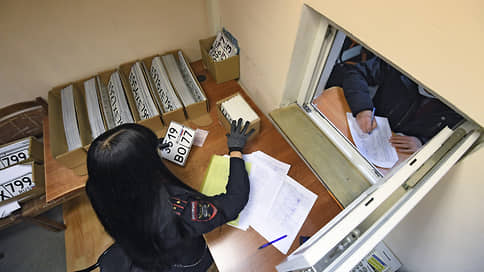Motorists were allowed to install square numbers in front
[ad_1]

Motorists were allowed to install so-called square numbers on the front: Rosstandart made changes to GOST, and the traffic police sent appropriate clarifications to the regions. Just a month ago, “non-standard” state registration marks were allowed only at the back; the authorities opposed easing the rules. After Kommersant’s publication, the authorities considered the problem urgent enough to change the regulatory documentation.
The ability to put “square” numbers on the front of the car (on the bumper) appeared in the amendment to GOST 50577-2018 “State registration signs for vehicles,” which Kommersant discovered in the Rosstandart database. Some automobile publicists also drew attention to this document on Saturday. The amendment came into force on October 18. Rosstandart did not issue a message or press release on this topic.
The so-called square license plates (type 1A), we recall, were introduced by amendments to GOST back in August 2020. Owners of Japanese, American and some Soviet vintage cars have the opportunity to install such state registration marks in standard factory mounts. Standard rectangular numbers did not fit there; we had to use various adapters. At the same time, for some reason, type 1A license plates were only allowed to be placed on the back, but not on the front: formally, this even resulted in a fine of 500 rubles.
For several years, motorists have been trying to get the restrictions lifted. As Kommersant reported, in mid-September, representatives of the Russian Automobile Association (RAF) approached Rosstandart with a request to still allow the installation of type 1A license plates in the front of the car. The organization pointed out the inconvenience experienced by car owners due to the ban. An example was given, in particular, of some Japanese SUVs (for example, Nissan Patrol) with a factory winch on the front bumper and a regular place for the square number. The standard rectangular license plate on such cars has to be attached to the side of the bumper; it protrudes beyond the dimensions of the car and can injure pedestrians. On other Japanese cars, the number covers the parking sensors, some lights and engine ventilation. On September 18, in response to a request from Kommersant, Rosstandart reported that the RAF proposal was recognized as “inappropriate.”
After the publication of Kommersant, the position of the authorities for some reason changed. On October 6, the deputy chairman of the RAF classic cars committee, Petr Shlyakhin (it was he who initially contacted Rosstandart), received an official response from the Federal Agency for Technical Regulation and Metrology, which said that the agency was not against amending GOST, “taking into account the relevance of the issue” ( “Kommersant” has the text of the answer). Kommersant has not yet been able to obtain official explanations from Rosstandart. The traffic police, according to Kommersant, sent clarifications to regional departments on October 20, indicating that changes to the standard should be communicated to personnel in order to prevent “illegal” prosecution of drivers.
“Finally, another restriction on the rights and freedoms of citizens has been lifted,” Pyotr Shlyakhin told Kommersant. “From the point of view of traffic safety, the installation of square numbers did not affect anything. In other countries this has been allowed for a long time: we saw it on cars in Moldova, Armenia, and other countries. In Russia it was still prohibited for some strange reasons. But, thank God, reason prevailed.” “We are very glad that the state responds so quickly to the needs of the population, and we welcome any such changes in regulations,” adds Alexander Tuzov, Chairman of the Union of Manufacturers of State Registration Vehicle Markings. “The main thing is to provide citizens with convenience. If a car owner wants to put two square numbers on his car, let him put it on! This does not affect traffic safety in any way. Moreover, road cameras have long been able to recognize any set of characters in a state registration mark – the form factor does not play any role in this.”
[ad_2]
Source link








